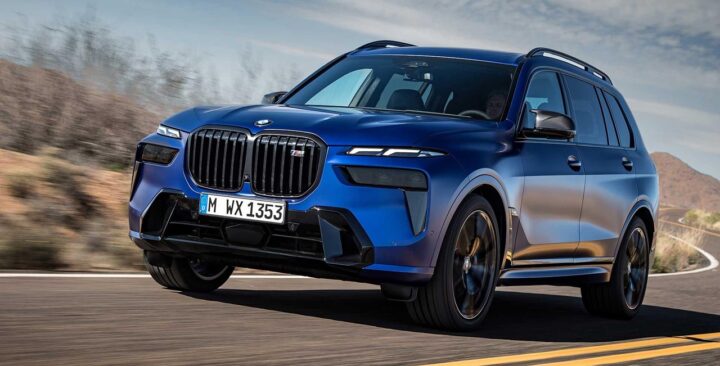
BMW X7 Facelift (2022): The BMW X7 gets a new front for the facelift
In addition to illuminated kidneys, BMW also gave the X7 a new arrangement of the lights for the facelift. The facelift of the large SUV in detail!
The BMW X7 was anything but reserved when it was launched in 2019. At the time, the powerful SUV derivative of the 7 Series attracted attention mainly because of its oversized double kidney. Now there’s a facelift – and in terms of the eye-catching front design, it ties in seamlessly with the original model.
The reason: BMW is giving the new X7 the new upper-class face as the first series. In addition to a sharpened design, the SUV gets a new cockpit and new decor. Under the hood, all engines become mild hybrids.
Optics: The X7 gets a facelift again
In the future, the BMW X7 will have a front that is divided horizontally into two parts, consisting of daytime running lights, main headlights and the large grille. The double kidney can now also be optionally illuminated.
On the side, nothing really changes for the facelift, but there is the option of the largest set of rims on a series BMW to date. At 23 inches, the wheels are a full two inches larger than before; this should increase the presence of the X7. The rear gets new taillights, whose chrome strip now runs under Plexiglas.
Dimensions: Facelift often only visible in detail
The new aprons have an impact on the external dimensions of the BMW X7 – however, the adjustments are limited, which is why the differences to the predecessor are small.
The dimensions of the new BMW X7 at a glance
● Length: 5162mm
● Width: 2000mm
● Height: 1819mm
● Wheelbase: 3105mm
Interior: BMW remixes the X7
Basically, BMW does not change anything on the interior concept with the three rows of seats in the X7. The standard seven-seater layout remains; optionally the SUV becomes a six-seater with more comfort.
Probably the most striking innovation can be seen in the cockpit. In the future, the X7 will also have the curved display, which combines the 12.3-inch instrument cluster and the 14.9-inch infotainment screen under one glass surface.
The new BMW OS 8.0 operating system is also moving into the X7. The new inlays in the dashboard are x-rayed and show an X7 lettering.
Equipment: new infotainment for the SUV
With the infotainment update of the X7, the latest assistants are also moving into the BMW. In the future, the SUV will also have functions such as Speed Limit Assist or the reversing assistant for an additional charge. The latter allows the car to maneuver back up to 200 meters long routes exactly as they were previously driven by the driver.
A new comfort package gives the rear USB ports with up to 45 watts of charging power, which is also enough to charge a notebook.
Engines: BMW X7 only as a mild hybrid
Basically, the BMW X7 retains the well-known range of engines. In the base, however, the large SUV now has 47 hp more. There will still be no plug-in hybrid – all units are now equipped with a 48-volt network and belt starter generator – in other words, with a mild hybrid drive. The generator provides a short boost if required and delivers up to 12 hp and 200 Nm in all three models.
In addition to the entry-level model X7 xDrive 40i with a 380 hp in-line six-cylinder, there is still only one diesel: The xDrive 40d also works with a straight-six that delivers 340 hp. The top model M60i xDrive stays with the V8 and 530 hp.
The X7 engines at a glance
● BMW X7 xDrive 40i engine: straight-six petrol engine; Displacement: 2998 cc; Power: 380 hp (280 kW); Torque: 540 Nm; combined consumption: 10.5 l/100 km; Transmission: eight-speed automatic
● BMW X7 xDrive 40d engine: straight-six diesel; Displacement: 2993 cc; Power: 340 hp (250 kW); Torque: 700 Nm; combined consumption: 8.7 l/100 km; Transmission: eight-speed automatic
● BMW X7 M60i xDrive engine: V8 petrol engine; Displacement: 4395 cc; Power: 530 hp (390 kW); Torque: 750 Nm; combined consumption: 13.3 l/100 km; Transmission: eight-speed automatic
Categories: General
